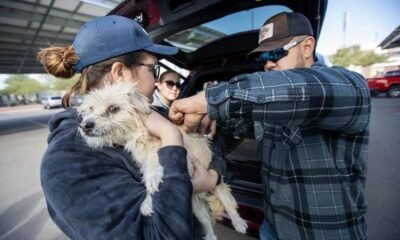Business
Canine Companions: How Hospital Dogs Alleviate Stress for Staff and Patients

DENVER — Outside HCA HealthONE Rose Medical Center, snowflakes dance in the air, signaling the onset of winter. Inside, however, the atmosphere is charged with excitement and purpose, particularly on the bustling third floor, where the labor and delivery unit operates at full capacity.
“It’s an exhilarating place to be; the energy can be intense,” commented Kristina Fraser, an OB-GYN, clad in blue scrubs as she prepped for the day’s work. The urgency of the moment is palpable as nurses wheel in expectant mothers ready to welcome new lives. “We’re going to bring a baby into this world safely,” said Fraser, showcasing her resolve and commitment.
In a brief but significant interlude, Fraser turned to two four-legged companions making the rounds — a pair of specially trained Labradors. “I don’t know if a human baby smells as good as that puppy breath!” she joked, and laughter erupted among her colleagues. The dogs, part of the hospital’s therapeutic initiative, aim to alleviate the stress experienced by medical staff.
These canines, particularly suited for this atmosphere, are trained to foster a calming presence, minimizing the stress levels that often accumulate in healthcare settings. “It’s amazing to see how a pet can bring everyone down to earth for a moment,” Fraser remarked. Staff members engage carefully with the pups, adhering to hygiene protocols to ensure patient safety.
The mental health crisis among healthcare providers is escalating, with reports indicating that nearly half experienced burnout in 2022, according to the Centers for Disease Control and Prevention. Such pressures have driven advocacy for the inclusion of therapeutic animals in hospitals, aiming to combat rising levels of anxiety and depression among medical professionals.
Among those leading this initiative is Susan Ryan, an emergency medicine physician at Rose. After years in the demanding field, she began suffering from PTSD, isolating herself while battling the emotional aftershocks of her experiences. “I just was messed up and I knew it,” Ryan said, highlighting the often-hidden struggles of healthcare providers.
To address her mental health, Ryan turned to therapy involving horses but later adopted a Labrador. This initiative blossomed into a program where she became the first doctor to integrate a facility dog into an emergency room, drawing upon resources from Canine Companions, a service dog organization.
With the hospital’s approval, Ryan and her colleagues embraced the presence of her dog, Peppi. Feedback has been overwhelmingly positive. EMT Jasmine Richardson shared, “When I have a bad day at work, Peppi is here to lift my spirits. He has this intuitive ability to brighten the room.”
Ryan also recounted her experience with another dog, Wynn, during the height of the COVID-19 pandemic. “Wynn made a huge difference,” she reflected. The emotional burden on new nurses confronting death for the first time weighed heavily, and the presence of a dog offered solace during trying moments.
Tragically, Ryan noted the hospital system faced losses among its physician ranks due to suicide in recent years. “Anything that brings you back to the present helps ground you again,” she said, emphasizing that dogs can provide the much-needed calming influence amid distressing work environments.
Studies corroborate these insights, linking dog interactions to improvements in mood and anxiety levels. Casey Guber, president and CEO of Rose, even became so convinced of the benefits that he brought his own trained dog to work, affectionately dubbed Ralphie and wearing the title of Chief Dog Officer. “Ralphie is a phenomenal morale booster,” he said, often seen bringing delight to both staff and patients alike.
As HCA HealthONE Rose Medical Center continues to innovate in the face of an ongoing mental health crisis, the integration of therapy dogs stands out as a heartening and effective initiative. The journey to healing — both physical and emotional — is open to new possibilities, one wagging tail at a time.


















